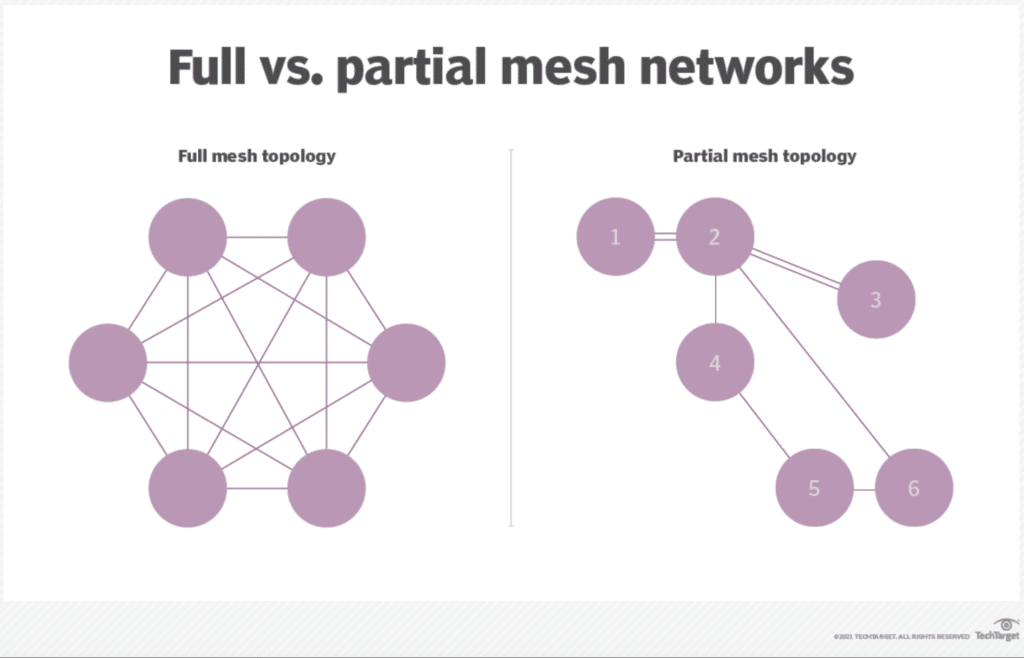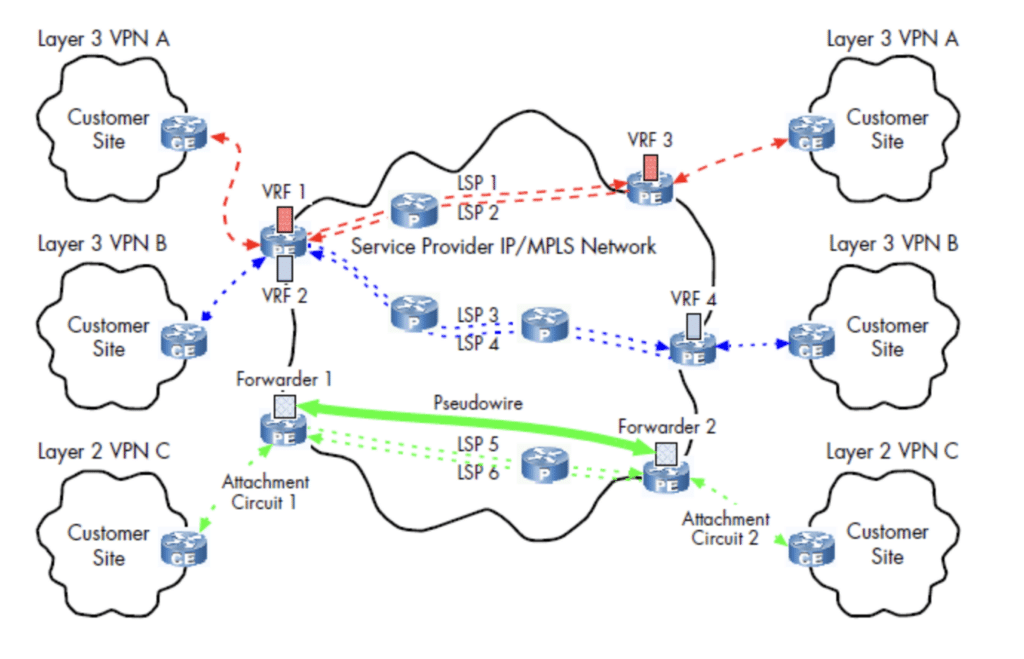Best practices for ways to connect your Wide Area Network (WAN) have evolved in recent years. With the rise of SD-WAN and SASE solutions for network monitoring and security, some technologies behind WAN connectivity, like MPLS, are seen by many network teams as outdated and costly. Still, I talk to a lot of customers who aren’t moving off their MPLS network any time soon.
Customers can deploy a variety of ways to connect their WAN within their topologies depending on their business objectives. Just as there’s no superior WAN topology, no one connectivity method is dominant over any other. Each has its own features, advantages, and disadvantages.
In this blog, I’ll run through the common WAN topologies and ways to connect your WAN, and use customer use cases to illustrate why companies choose one or a set of connectivity methods over others.
Common WAN topologies
Point-to-Point WAN
Locations and devices on a point-to-point WAN are connected using a dedicated circuit at layer 2. If you have Site A in one city and Site B in another, the network diagram might look like this, courtesy of Cisco Press:

Use Cases
We have many different types of customers who use a P2P WAN topology.
In the case of a leading data warehousing company, it uses six different data center operators across 11 locations in the US and Europe. The company uses PacketFabric to connect these data centers with long-haul EPL (P2P) circuits, provisioned virtually on our portal.
Examples of connections include:
- a 100G long-haul circuit from a data center in Salt Lake City to a data center in Denver to support their cloud storage deployments.
- Redundant 100G long-haul circuits from Ashburn, Virginia to Chicago, Illinois
- Redundant 10G virtual circuits between data centers in London and Frankfurt
Another example was highlighted on our blog. A visual effects studio with on-prem infrastructure in Oregon used a 100G dedicated cloud connection from PacketFabric to connect to Google Cloud in Oregon in order to lower latency.
Point to Multi-point WAN
Point to Multi-point (P2MP) WAN is also known as a hub-and-spoke or Tree WAN design. Sites are connected to a central site or hub so a simple version of the network might look like this, courtesy of CCNA:

Use Cases
Often there are elements of one WAN topology in another. In the case of the data warehousing customer, within their overall P2P WAN topology, they used P2MP as well, connecting data centers in Boston and Chicago with redundancy to their Ashburn data center, without connecting the Boston and Chicago data centers together. In this case, the Ashburn data center becomes the hub.
Another example of a P2MP WAN topology is when traffic from multiple sites is aggregated at a PacketFabric Virtual Cloud Router. The Virtual Cloud Router is the hub, while the data centers and cloud deployments end up being spokes in the network.
Mesh WAN
Also known as a Star WAN topology, a meshed WAN connects numerous sites not just one to the other to the next, but also together. Here’s what a full mesh WAN and a partial meshed WAN might look like, courtesy of TechTarget.

You can see in the full mesh example, the network connections resemble a star.
Use Cases
A full mesh six-site WAN topology was used as an example in our blog “Three Reasons to Upgrade Your Network Backbone.” In that case, six data centers were connected with virtual circuits to a Virtual Cloud Router, creating a “mesh” as every data center could conceivably pass traffic to any other in an any-to-any software-defined network (SDN).
The blog also features a diagram of how that full mesh WAN was designed with nailed-up connections as well. To build a full meshed WAN with P2P connections, you have to provision many more connections. By using a Virtual Cloud Router as a hub, you can reduce the number of connections you need, making your network more efficient both from a data transfer and cost perspective.
MPLS
Multi-Protocol Label Switching (MPLS) is a technology that uses routers to forward data across the network. The routers use labels applied to data packets, which helps the network identify the best path for the packet to take to its destination.
An MPLS topology might look like this:

MPLS was originally developed in 1990s and is now considered an aging technology. But many companies still prefer the speed and reliability of an MPLS network. While an MPLS network is typically performant and reliable, it has a high-per-megabit cost and is sold by traditional telcos. It also involves purchasing and managing Customer Premises Equipment (CPE).
As you can tell from the diagram above, an MPLS network can also be more complex to manage than other WAN topologies.
Use Cases
We’ve worked with companies to simplify their WAN, and featured one of these use cases in this blog about a fintech’s multi-cloud network. Many companies are moving away from MPLS to a more modern WAN technology, one that’s becomes an oft-used analyst buzzword in this decade.
SD-WAN
Software-Defined Wide Area Networking is a network where SD-WAN devices are deployed to connect branch offices, and network teams can orchestrate and monitor these devices with software. SD-WAN often involves the deployment of firewalls and other devices to secure company traffic. In most cases, SD-WAN devices rely on internet connectivity, which can make network performance unreliable.
SD-WAN technology came to the forefront when office workers started using social media in the workplace. Traffic was so heavy within private corporate networks that companies needed a solution that enabled workers to use less expensive internet bandwidth while maintaining network security at the branch-office level.
Here’s a video that explains how SD-WAN changes traditional WAN topologies:
Use Cases
One of the main disadvantages of SD-WAN is that it uses low-cost internet connectivity instead of more reliable MPLS connectivity. SD-WAN enables companies to better manage, orchestrate, and secure network traffic, but often at the cost of application performance.
We’ve spoken to customers who have deployed firewalls at multiple branch offices only to become frustrated with frequent outages. We’ve designed alternate WAN solutions in which SD-WAN traffic gets aggregated on Virtual Cloud Routers. Traffic is then brought onto PacketFabric’s private network, where bandwidth is less likely to be throttled and security is stronger than the public internet.
Common WAN Connectivity Methods
Now that we’ve gone over different WAN topologies, let’s look at how sites can be connected within these network designs. As I mentioned above, choosing WAN connectivity methods often boils down to whether or not you can put up with the unreliable network performance and untrustworthy security aspects of public internet connectivity.
Broadband or T1 (internet)
Broadband, such as DSL, is equivalent to standard internet connectivity. It’s the easiest, cheapest way to connect sites on your WAN. T1 is another internet option that’s typically delivered over copper wires. It’s a stronger internet connection (1.544 Mbps), but still has the security and bandwidth limitations of broadband.
For applications that don’t necessarily require optimal user experience, broadband or T1 connectivity may be the most cost-effective options.
Ethernet
There are several types of Ethernet connections. Ethernet Private Lines (EPL) are used for point-to-point connections, while Ethernet Virtual Private Lines (EVPL) can be used for point-to-multipoint connections. Bandwidths start at 1G, so from a speed perspective, they’re a step up from broadband or T1s. They’re also private lines so they’re more secure than internet connectivity.
Both are layer 2 connections, meaning there’s a physical connection and a software interface that allows you to control and see where your data goes. The virtual interface enables you to turn up EPLs and EVPLs via software-defined networking platforms like the PacketFabric portal.
On our private, carrier-grade network, for example, if there’s an issue with the Ethernet line, data can be routed to an alternate path without service interruption. The customer does not have to deal with physical infrastructure.
Use cases include large-scale data migrations or file transfer, data center interconnectivity, and disaster recovery.
Wavelengths
Wavelengths transmit data with light over a fiber optic cable. Most carriers offer waves with bandwidths up to 100G, and some offer even higher bandwidths.
Waves are layer 1 connections, meaning they’re physical and static–data moves unidirectionally from one node to another. Waves have to be ordered and installed by your carriers, and in many cases, installation can take weeks or even months, particularly if you’re using them for long-haul transit.
If there are issues with your waves, like a gopher chews through your cable, it has to be physically repaired, so designing your network for redundancy is key.We’ve seen that companies in industries with more stringent compliance and regulatory requirements tend to prefer procuring physical connections prefer wavelength connectivity.
MPLS circuits
Carriers offer several types of MPLS circuits, including layer 2 point-to-point and VPN. These are typically either internet or Ethernet connections to MPLS routers. These connections also tend to be pricier as they’re part of carrier-managed MPLS offerings.
MPLS has been a popular technology for decades, particularly for companies that need to connect numerous branch office locations to data centers.
Summary
Here is a table of the different ways to connect your WAN ranked by business criteria (1 being best and 4 being worst). Choose the most important ones and rank them to help you make decisions for your use case.
| Method v. Criteria | Broadband or T1 (internet) | Ethernet (EPL,EVPL) | Wavelengths | MPLS |
| Bandwidth | 4 | 2 | 1 | 3 |
| Reliability | 4 | 3 | 3 | 1 |
| Scalability | 4 | 1 | 2 | 3 |
| Security | 4 | 2 | 1 | 3 |
| Flexibility | 2 | 1 | 4 | 3 |
| Cost | 1 | 2 | 3 | 4 |
Using Software-Defined Connectivity
No matter what your WAN topology is, PacketFabric offers almost any WAN connectivity option on our portal. You can connect WAN sites using dedicated internet access and Ethernet (both EPL and EVPL) connectivity as a virtual alternative to physical wavelengths, all at bandwidths up to 100G.
With almost every company using one or more cloud service providers, hybrid and multi-cloud connectivity are also key components of a typical enterprise’s WAN. We covered ways to connect to multi-cloud in this blog.
Our sales engineers will also help you design a network based on your business objectives, which could be maximum resilience and redundancy or optimal cost efficiency.
Reach out to one of our sales engineers if you’re looking to modernize your WAN.